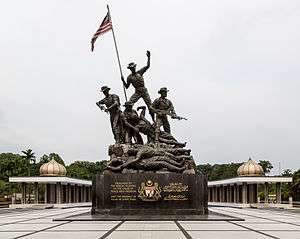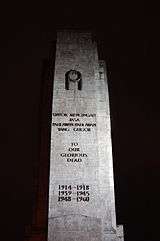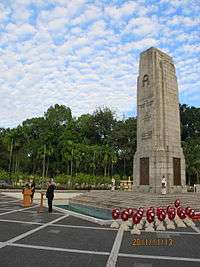National Monument (Malaysia)
| National Monument (Tugu Negara) | |
|---|---|
| Malaysia | |
 | |
| For Malaysian military sacrifices during the struggle for freedom. | |
| Unveiled | 1966 |
| Location | near Kuala Lumpur, Federal Territory |
| Designed by | Felix de Weldon |
The National Monument is a sculpture that commemorates those who died in Malaysia's struggle for freedom, principally against the Japanese occupation during World War II and the Malayan Emergency, which lasted from 1948 until 1960. It is located in the Federal capital, Kuala Lumpur. The Malaysian Houses of Parliament are situated near the monument.
It is the world's tallest bronze freestanding sculpture grouping.[1] Every year on 31 July on Warriors' Day, the Yang di-Pertuan Agong, the Prime Minister, heads of military, and the police pay their respects to the fallen heroes by laying garlands at the monument.
History
Kuala Lumpur cenotaph

The predecessor of the National Monument is an interwar-era cenotaph originally erected by the colonial British administration on a 10m flat grass-covered ground on a roundabout adjoining Victory Avenue (now part of Jalan Sultan Hishamuddin) and Raja Road, close to the Kuala Lumpur Railway Station and Railway Administration Building. Originally intended to commemorate the Great War (1914–1918) and honour those from the British Malayan colonies who were killed in the war, the cenotaph's inscription would later include fallen British Malayan soldiers of World War II (1939–1945) after the conclusion of World War II and resumption of British rule. Names of the fallen are engraved on the plaques of the cenotaph as a token of tribute to their sacrifices.
In 1964, the cenotaph was moved from its original location to the site of the National Monument in Lake Gardens before a planned flyover connecting Jalan Sultan Hishamuddin and the Parliament roundabout was constructed over the original site. Transfer of the cenotaph was made possible by dismantling the structure into catalogued parts, allowing the structure to be transported in pieces and reassembled in its original form at the National Monument. Following its move, inscriptions were added to include fallen soldiers from the Malayan Emergency (1948–1960) and an archaic Malay translation of "To Our Glorious Dead", "Untok Mengingati Jasa Pahlawan-pahlawan Yang Gugor" ("To Remember the Service of Warriors Who Have Fallen").
National Monument
The concept of a national monument was mooted by Malaysia's first Prime Minister Tunku Abdul Rahman, who was inspired by the Marine Corps War Memorial during his visit to the United States in October 1960, before personally meeting Felix de Weldon for a favour to design the monument.
The National Monument was completed and officially opened on 8 February 1966, by Ismail Nasiruddin of Terengganu, then Yang di-Pertuan Agong. It was proclaimed a memorial park dedicated to the 11,000 people who died during the 12-year Malayan Emergency (1948–1960). Thereafter, a wreath-laying ceremony takes place at the monument every 31 July on Warriors Day. De Weldon was later conferred with the title Tan Sri, the Malaysian equivalent of a high-ranking knighthood.
On 27 August 1975, the monument suffered extensive damage due to an explosion set off by a communist terrorist. It has since been restored to its original state with the renovated statues unveiled on 11 May 1977. A fence was then erected and the complex was declared a protected area between sunset and dawn. Every day at dawn, a soldier raises the national flag and lowers it at dusk.

Minister in the Prime Minister's Department Jamil Khir Baharom has stated that from 2010, the Warriors' Day commemoration service would be held elsewhere after Malaysia's National Fatwa Council guidelines declared the statues "un-Islamic" and potentially idolatrous. Defence Minister Zahid Hamidi added that a new "Warrior's Square" would be built in the country's administrative capital Putrajaya. When asked why the decision was made only after almost four decades of celebrating Warriors' Day at the present site, Jamil evaded comment, saying "Alhamdulillah, we are serious in solving this issue".[2] A similar sentiment would later be echoed in September 2016 by Harussani Zakaria, a Perak-based mufti, who declared that the construction of the monument had been a "big sin" and "idolatrous", because building monuments in the shape of humans was haram in Islam.[3]
Design
Commissioned in 1963 and constructed in 1966, the sculpture that stands as a centrepiece of the monument is 15 meters (49.21 feet) tall, made of bronze and was designed by Austrian sculptor Felix de Weldon, who was also responsible for the Marine Corps War Memorial in Virginia, United States.
The sculpture depicts a group of soldiers, with two slumped at the base and one holding the Malaysian national flag aloft. Each of the bronze figures symbolises leadership, suffering, unity, vigilance, strength, courage and sacrifice. The stones that the soldiers are standing on were imported from the small coastal city of Karlshamn in South Eastern Sweden.
The granite base of the sculpture bears the Malayan Coat of Arms, flanked on either side by inscriptions in English, Latin script, and also in Malay in Jawi script:
Dedicated to the heroic fighters in the cause of peace and freedom,May the blessing of Allah be upon them
Jalan Tugu
Jalan Tugu, originally known as Cenotaph Road, refers to a road which was laid out following the completion of the cenotaph and adjoins the original cenotaph roundabout. The road was renamed to a direct Malay translation of the English name following a street renaming campaign during the 1960s, and continues to carry this name, as of 2013. The road runs parallel to the Kuala Lumpur Railway Station, and is located opposite the Railway Administration Building and National Mosque.
References
- ↑ "Tugu Negara". welcome-kl.com. Retrieved 16 July 2012.
- ↑ http://www.sun2surf.com/article.cfm?id=44972
- ↑ https://www.malaysiakini.com/news/354761
External links
| Wikimedia Commons has media related to Tugu Negara. |
- In honour of our fallen heroes, New Straits Times, 16 December 2005.
- Monuments to honour the dead, The Star, 28 July 2007.
- National Monument "unsuitable" for Warriors' Day, The Sun, 31 March 2010.
- Tourism Malaysia - National Monument
- Tugu Negara